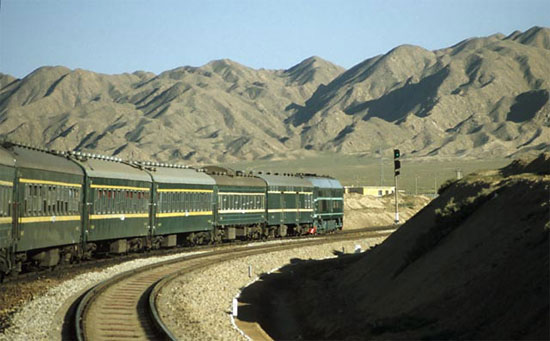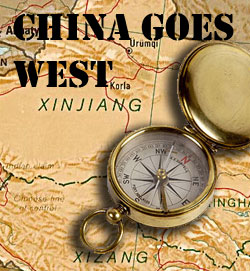Gansu: China’s Central Distribution Axis
Aug. 18 – A few years ago I embarked on a business trip to explore opportunities in China’s western regions. Mindful of the need to “stick a Dezan Shira flag” in each one of China’s provinces, by which meaning I was determined to attract clients in each, my recreation of the Silk Road journey meant I traveled from Xi’an to Ningxia, Gansu and Xinjiang. Of each of these destinations, however, it is Gansu which despite its size, remains relatively off the map as regards exposure to foreign investment.
Partly carved out of desert, the old Tibetan Province of Amdo, with the Yellow River slurping its way east, Gansu is also home to China’s nuclear testing and space exploration base, and for decades has been the home to much of China’s heavy industry. It’s an inhospitable terrain and, despite recent investment, somewhat inadequate transport links mean that the province has not made the most of its natural resources.
The province is strategically located in the heart of China, and this is starting to make it attractive as a distribution and logistics center. Investment is continuing in the road and rail sectors, and this means that Gansu is developing as a conduit from which all corners of China can be accessed. Indeed, it remains the only province that connects the east of China to the west and links the north and south in West China.
The northwestern parts of the province are sandwiched between Qinghai, Xinjiang and Inner Mongolia, while to the south it has provincial borders with Sichuan, Shaanxi and Ningxia, making it an excellent location for the production, warehousing and distribution of products to these massive domestic Chinese markets.
A total of six national highways and four national rail lines run through the provincial capital of Lanzhou. There are flights to 30 other domestic cities throughout China as well as to Hong Kong, and from Lanzhou, daily flights to and from Beijing, Shanghai, Guangzhou, Shenzhen and Xi’an. It’s the increasing connectivity that is the new key to unlocking Gansu’s potential, with a regional market of Gansu and its neighboring provinces of a fifth of China’s total population at some 265 million people.

Gansu itself covers an area of 450,000 square kilometers and has a population of 26.35 million, while in natural resources it possesses large quantities of coal, copper, gypsum, iron, mirabilite, crude oil, tungsten, and zinc. Agricultural products include cotton, linseed oil, maize, melons, millet, and wheat as well as a number of herbs used in Chinese medicine. Much of the province, particularly the northern reaches, is desert and poorly suited to agriculture. The image of the province as a domestic distribution hub is not immediately apparent, however some study of Gansu reveals that this is indeed where its potential lies. Gansu is 2,000 kilometers away from Tianjin, the nearest seaport, and that has made it something of a backwater when it comes to FDI. That same distance is also what makes the province alluring – the close proximity to China’s massive domestic markets. Hand in hand with the government’s desire to open up China as a consumer market, state subsidies have kicked in here, permitting agricultural products in particular to be sold with a state financed subsidy. That is good news for manufacturers of such items. It’s led to something of a mini boom and despite its reputation as one of China’s poorer regions, Gansu’s GDP has grown at over 10 percent in the last 10 years, on average, and is currently outperforming the entire nation.
Key industries in the province include mining, metallurgy, energy, petrochemicals, and oil exploration machinery. Gansu also boasts large reserves of coal, natural gas and petroleum, and the province is also important to China’s nuclear industry. In terms of agriculture, Gansu has 16.6 million hectares of grasslands, one-fifth of all the provinces in China, and was a major agricultural base. However, a lack of water resources has now damaged this sector although, as mentioned, there are incentives being provided to turn this decline around.
Foreign investment has undergone something of a renaissance since 2007, mainly on the back of recognition of its importance as a strategic hub. Investors such as DuPont, Coca Cola, National Oil, Veolia Water and Carlsberg have all chosen Lanzhou as a home because of this and the reemergence of Gansu as a strategically important hub for reaching China’s inland markets is gaining pace. In common with other western regions, the province is a beneficiary of the “Go West” campaign, and tax breaks and incentives can be found here that have long gone from China’s more eastern provinces and cities. Wages and land costs are also considerably less than in the increasingly expensive eastern cities and run at about 25 percent to 30 percent of those found in Shanghai, for example. The minimum wage in Lanzhou is RMB620, one of the lowest in China.
There are two state-level development zones in Lanzhou, and a further 34 provincial level zones at Lianhai, Baiying, Jinchang, Tianshui, Dunhuang, Linxia, and Wenfeng covering a variety of specific industries including metal extraction, trading, tourism packaging and pharmaceuticals. For businesses looking to sell products to China’s domestic markets, Gansu is well worth considering.
Lanzhou also has a few quirks of its own. Locals are very proud of the massive wrought iron bridge that spans the Yellow River here and are equally proud to be associated with Germany as a result. The bridge was constructed by German engineers many years ago and to be German in Lanzhou is a definite bonus. The famous Lanzhou noodles, probably the closest that China comes to Italian spaghetti, may be what inspired Marco Polo to take the recipe back to Venice. The legendary English footballer Paul Gascoigne even once turned out for the local soccer club towards the end of his playing career – 40,000 fans turned up at the local soccer stadium to watch. Anything is possible, it seems, in Gansu, and for foreign investors interested in expanding operations inland, Lanzhou is becoming an increasingly attractive proposition.
Chris Devonshire-Ellis is the principal and founding partner of Dezan Shira & Associates. The firm has 18 years of foreign investment experience throughout China, including Gansu. For assistance and advice over laws, taxes and incentives for foreign investment in Gansu please contact the firm at info@dezshira.com. Chris also contributes to India Briefing , Vietnam Briefing , Asia Briefing and 2point6billion
Related Reading
The Complete “China Goes West” Series
Going West
(Includes complimentary back issues of Western Region themed editions of China Briefing Magazine)
Lanzhou City Guide
(Complimentary download)
Business Guide to West China
(Includes Gansu, Guizhou, Ningxia, Qinghai, Shaanxi, Sichuan, Tibet, Yunnan and Xinjiang)
Business Guide to Central China
(Includes Henan, Hubei, Hunan, Inner Mongolia, Jiangxi and Shanxi)
- Previous Article Stability and Development Twin Concerns for China in Central Asia
- Next Article SAT Releases Notice on VAT Input Tax Deductions in Fund Projects














